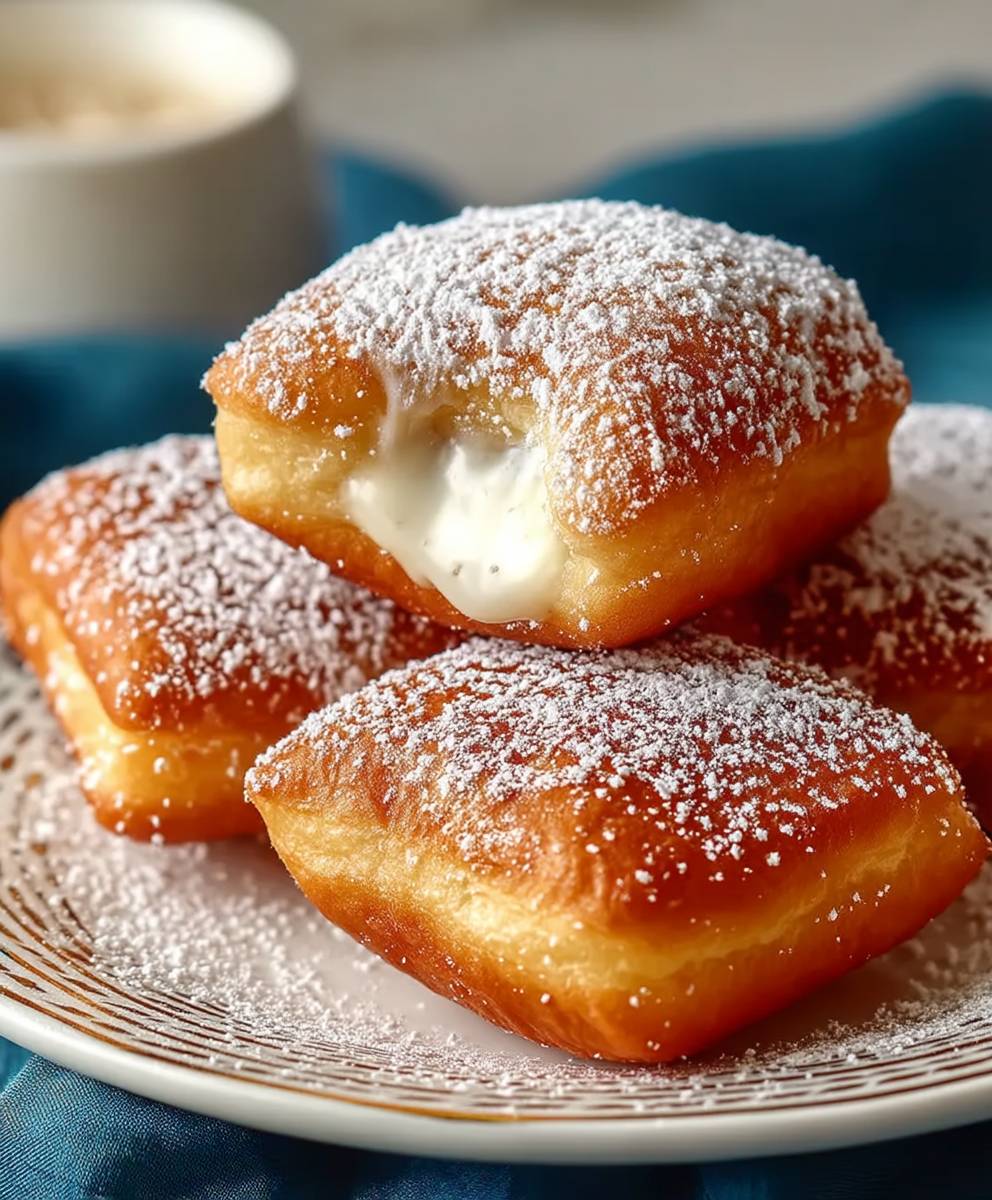Vanilla French Beignets: Imagine biting into a cloud of golden-brown, pillowy dough, dusted with a generous snowfall of powdered sugar, and infused with the delicate aroma of vanilla. That, my friends, is the magic of a perfectly made beignet, and I’m thrilled to share my foolproof recipe with you!
These delightful fritters have a rich history, deeply rooted in French culinary tradition. Brought to New Orleans by the Acadians, beignets quickly became a beloved staple, synonymous with the city’s vibrant culture and the iconic Café du Monde. They represent a simple pleasure, a sweet escape, and a taste of history all rolled into one irresistible package.
What makes Vanilla French Beignets so universally adored? It’s a combination of factors, really. The light and airy texture, achieved through careful dough preparation and frying, is simply divine. The subtle sweetness, enhanced by the vanilla, is comforting and satisfying without being overwhelming. And let’s not forget the sheer joy of creating these little treats at home! Whether you’re looking for a special breakfast, a delightful dessert, or simply a way to bring a touch of New Orleans to your kitchen, these beignets are guaranteed to be a hit. Plus, they are surprisingly easy to make, making them perfect for both beginner and experienced bakers alike. So, let’s get started and create some beignet magic!
Ingredients:
- For the Dough:
- 1 cup warm water (105-115°F)
- 1/4 ounce (about 2 1/4 teaspoons) active dry yeast
- 1/4 cup granulated sugar
- 1 teaspoon salt
- 2 large eggs, lightly beaten
- 1/4 cup evaporated milk
- 1 teaspoon vanilla extract
- 4 cups all-purpose flour, plus more for dusting
- 1/4 cup (1/2 stick) unsalted butter, melted
- For Frying:
- Vegetable oil, for frying (about 4-6 cups)
- For Serving:
- Powdered sugar, for dusting
Preparing the Dough:
- Activate the Yeast: In a large bowl, combine the warm water and yeast. Let it stand for 5-10 minutes, or until the yeast is foamy. This step is crucial to ensure your beignets rise properly. If the yeast doesn’t foam, it’s likely dead, and you’ll need to start with fresh yeast.
- Combine Wet Ingredients: Add the sugar, salt, eggs, evaporated milk, and vanilla extract to the yeast mixture. Whisk well to combine all the wet ingredients. The evaporated milk adds a richness and tenderness to the dough that I find really elevates the flavor.
- Add Flour and Butter: Gradually add the flour, one cup at a time, mixing well after each addition. After adding about half of the flour, add the melted butter. Continue adding the remaining flour until a soft dough forms. The dough should be slightly sticky but manageable. Don’t add too much flour, or your beignets will be tough.
- Knead the Dough: Turn the dough out onto a lightly floured surface. Knead for 5-7 minutes, or until the dough is smooth and elastic. You can also use a stand mixer with a dough hook for this step. If using a mixer, knead on medium speed for about 5 minutes. The dough should be soft and pliable.
- First Rise: Place the dough in a lightly oiled bowl, turning to coat all sides. Cover the bowl with plastic wrap or a clean kitchen towel. Let the dough rise in a warm place for 2 hours, or until doubled in size. This first rise is essential for developing the flavor and texture of the beignets. I usually place my dough in a slightly warmed oven (turned off!) to create a consistent warm environment.
Rolling and Cutting the Dough:
- Punch Down the Dough: After the dough has doubled in size, gently punch it down to release the air. This helps to redistribute the yeast and create a more even texture.
- Roll Out the Dough: Turn the dough out onto a lightly floured surface. Using a rolling pin, roll the dough out to about 1/4-inch thickness. Try to keep the dough as even as possible to ensure even cooking.
- Cut the Beignets: Use a sharp knife or a pizza cutter to cut the dough into 2-inch squares. You can also use a cookie cutter to create different shapes, but squares are the traditional beignet shape.
- Second Rise: Place the cut beignets on a baking sheet lined with parchment paper. Cover them loosely with plastic wrap or a clean kitchen towel. Let them rise for another 30-45 minutes. This second rise is important for creating light and airy beignets.
Frying the Beignets:
- Heat the Oil: Pour vegetable oil into a large, heavy-bottomed pot or Dutch oven. You’ll need enough oil to fully submerge the beignets, about 2-3 inches deep. Heat the oil over medium heat to 350-375°F (175-190°C). Use a deep-fry thermometer to monitor the oil temperature. Maintaining the correct temperature is crucial for achieving perfectly cooked beignets. If the oil is too hot, the beignets will brown too quickly on the outside and remain raw on the inside. If the oil is not hot enough, the beignets will absorb too much oil and become greasy.
- Fry the Beignets: Carefully place a few beignets into the hot oil, being careful not to overcrowd the pot. Fry for 2-3 minutes per side, or until golden brown and puffed up. Use a slotted spoon or spider to turn the beignets and remove them from the oil.
- Drain the Beignets: Place the fried beignets on a wire rack lined with paper towels to drain excess oil. This helps to keep them from becoming soggy.
Serving the Beignets:
- Dust with Powdered Sugar: While the beignets are still warm, generously dust them with powdered sugar. The warmth of the beignets will help the powdered sugar adhere better. Don’t be shy with the powdered sugar – it’s part of what makes beignets so delicious!
- Serve Immediately: Serve the beignets immediately while they are still warm and fresh. They are best enjoyed right away, as they tend to lose their crispness over time.
Tips for Perfect Beignets:
- Use Fresh Yeast: Make sure your yeast is fresh and active. If it doesn’t foam when mixed with warm water, it’s likely dead and won’t properly leaven the dough.
- Don’t Overmix the Dough: Overmixing the dough can result in tough beignets. Mix just until the ingredients are combined.
- Maintain the Correct Oil Temperature: Keeping the oil temperature consistent is crucial for achieving perfectly cooked beignets. Use a deep-fry thermometer to monitor the temperature.
- Don’t Overcrowd the Pot: Frying too many beignets at once can lower the oil temperature and result in greasy beignets. Fry in batches.
- Serve Immediately: Beignets are best enjoyed fresh and warm. Serve them immediately after frying and dusting with powdered sugar.
Variations:
- Chocolate Beignets: Add 1/4 cup of cocoa powder to the dry ingredients for chocolate beignets.
- Cinnamon Sugar Beignets: Toss the fried beignets in cinnamon sugar instead of powdered sugar.
- Filled Beignets: Cut a slit in the side of the fried beignets and fill them with your favorite jam, cream, or chocolate filling.
Troubleshooting:
- Beignets are not rising: Make sure your yeast is fresh and active. Also, ensure that the dough is rising in a warm place.
- Beignets are too greasy: The oil temperature may not be hot enough. Make sure the oil is between 350-375°F (175-190°C). Also, avoid overcrowding the pot.
- Beignets are browning too quickly: The oil temperature may be too hot. Reduce the heat and monitor the temperature closely.
- Beignets are tough: You may have added too much flour to the dough. Be careful not to overmix the dough.
Storage:
- Beignets are best enjoyed fresh, but you can store leftovers in an airtight container at room temperature for up to 24 hours. They will lose some of their crispness over time. You can reheat them briefly in a warm oven or microwave, but they are best when freshly made.
A Note on Vanilla:
- I use a good quality vanilla extract in this recipe. The vanilla really enhances the flavor of the beignets and adds a touch of warmth. You can also use vanilla bean paste for an even more intense vanilla flavor. If you’re feeling adventurous, try using a different extract, like almond or lemon, for a unique twist.
Why Evaporated Milk?
- You might be wondering why I use evaporated milk instead of regular milk. Evaporated milk has a higher concentration of milk solids, which gives the beignets a richer flavor and a more tender texture. It also helps to keep the beignets moist. If you don’t have evaporated milk on hand, you can substitute regular milk, but the texture might be slightly different.
Enjoy!
- I hope you enjoy making these vanilla French beignets as much as I do! They are a delicious treat that is perfect for breakfast, brunch, or dessert. Don’t be

Conclusion:
And there you have it! These Vanilla French Beignets are truly a must-try recipe that will transport you straight to a New Orleans cafe, no plane ticket required. The light, airy texture combined with the delicate vanilla flavor and the satisfying dusting of powdered sugar creates a symphony of sensations that’s simply irresistible. I promise, once you take that first bite, you’ll understand why I’m so enthusiastic about these little pockets of joy.
But what makes these beignets so special? It’s the perfect balance of simplicity and indulgence. The ingredients are readily available, the steps are straightforward, and the result is a treat that feels incredibly decadent. They’re perfect for a weekend brunch, a special occasion, or even just a spontaneous craving. Plus, the aroma that fills your kitchen as they fry is pure bliss!
Serving Suggestions and Variations:
While these Vanilla French Beignets are divine on their own, there are countless ways to customize and enjoy them. For a classic presentation, simply dust them generously with powdered sugar. However, don’t be afraid to get creative!
* Dipping Sauces: Serve them with a warm chocolate sauce, a creamy caramel dip, or even a tangy fruit compote. A simple glaze made with powdered sugar and a touch of milk or lemon juice is also a fantastic option.
* Flavor Variations: Experiment with different extracts! Almond extract, lemon extract, or even a hint of rum extract can add a unique twist to the flavor profile. You could also incorporate spices like cinnamon or nutmeg into the dough for a warm, comforting flavor.
* Filled Beignets: For an extra special treat, try filling the beignets with pastry cream, chocolate ganache, or your favorite jam after they’ve cooled slightly. Use a piping bag to inject the filling into the center of each beignet.
* Savory Beignets: Believe it or not, beignets can also be savory! Omit the vanilla extract and powdered sugar, and instead, add herbs like rosemary or thyme to the dough. Serve them with a cheese sauce or alongside a hearty soup.
* Coffee Pairing: These beignets are the perfect accompaniment to a cup of coffee. A strong, dark roast will complement the sweetness of the beignets beautifully. Or, for a truly authentic New Orleans experience, pair them with a cafe au lait.I truly believe that this recipe for Vanilla French Beignets is a winner. It’s easy enough for beginner bakers, yet impressive enough to wow your friends and family. The satisfaction of creating these delightful treats from scratch is incredibly rewarding, and the taste is simply unforgettable.
So, what are you waiting for? Gather your ingredients, preheat your oil, and get ready to embark on a culinary adventure. I’m confident that you’ll love these beignets as much as I do.
And most importantly, I’d love to hear about your experience! Did you try any of the variations I suggested? Did you come up with your own unique twist? Share your photos and stories in the comments below. I can’t wait to see your creations and hear what you think! Happy baking!
Vanilla French Beignets: A Delicious & Easy Recipe
Light, airy, and perfectly sweet vanilla French beignets, fried to golden perfection and dusted with powdered sugar. A classic New Orleans treat!
By: LilyCategory: DessertDifficulty: EasyCuisine: AmericanYield: 24 beignetsDietary: VegetarianIngredients
Instructions
Recipe Notes
- Yeast: Ensure your yeast is fresh and active. If it doesn’t foam, it’s likely dead.
- Dough: Don’t overmix the dough, or the beignets will be tough.
- Oil Temperature: Maintain the correct oil temperature (350-375°F) for even cooking.
- Frying: Don’t overcrowd the pot when frying.
- Serving: Beignets are best enjoyed fresh and warm.
- Variations:
- Chocolate Beignets: Add 1/4 cup of cocoa powder to the dry ingredients.
- Cinnamon Sugar Beignets: Toss the fried beignets in cinnamon sugar instead of powdered sugar.
- Filled Beignets: Cut a slit in the side of the fried beignets and fill them with your favorite jam, cream, or chocolate filling.
- Storage: Beignets are best enjoyed fresh, but you can store leftovers in an airtight container at room temperature for up to 24 hours.
Frequently Asked Questions
→ How do I ensure the bread stays moist?Use fresh, ripe ingredients and avoid overmixing the batter. Store in an airtight container.→ Can I substitute ingredients?Yes, you can substitute similar ingredients while maintaining the basic ratios for best results.→ How long does this bread keep?Store tightly wrapped at room temperature for 2-3 days, or refrigerate for up to a week.→ What if I don't have all the spices?You can adjust spices to taste or substitute with similar warming spices.→ Can I freeze this bread?Yes, wrap individual slices and freeze for up to 3 months. Thaw at room temperature before serving.




